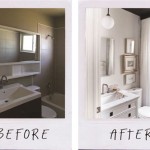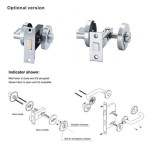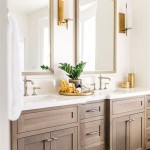28-Inch Bathroom Vanity with Sink: A Comprehensive Guide
The 28-inch bathroom vanity with sink represents a popular choice for homeowners seeking to optimize space without sacrificing functionality or style. These vanities strike a balance between providing adequate storage and fitting comfortably within smaller bathrooms, powder rooms, or even renovated spaces where maximizing usable area is paramount. The 28-inch size offers a notable upgrade in storage and countertop space compared to smaller, more compact options while remaining manageable in tighter quarters.
The selection of a suitable 28-inch bathroom vanity with sink involves careful consideration of several factors. Material durability, design aesthetics, storage configurations, and plumbing compatibility all play a crucial role in making an informed decision. Ignoring these aspects can lead to dissatisfaction with the purchase and potential complications during installation and long-term use.
Key Considerations Before Purchasing
Before embarking on the purchase of a 28-inch bathroom vanity with sink, careful planning is essential. This involves assessing the available space, understanding the existing plumbing configuration, and defining the desired aesthetic. A well-thought-out plan will streamline the selection process and ensure the chosen vanity seamlessly integrates into the bathroom.
First and foremost, accurate measurements of the bathroom space are crucial. The available width, depth, and height should be carefully noted. It is important to factor in any obstructions such as door swings, toilet placement, or other fixtures. Remember to allow for adequate clearance around the vanity to ensure comfortable movement within the bathroom. Consider the placement of plumbing lines. Knowing the location of the water supply and drain is essential for ensuring compatibility with the new vanity. Some vanities are designed with specific plumbing configurations in mind, and choosing one that aligns with the existing setup will simplify the installation process and minimize the need for costly modifications.
Identify the desired aesthetic for the bathroom. Do you prefer a modern, minimalist look, or a more traditional, ornate style? Consider the existing color scheme and architectural details of the bathroom when selecting a vanity. The goal is to choose a vanity that complements the overall design and enhances the visual appeal of the space.
Material Selection: Balancing Durability and Aesthetics
The material of the vanity cabinet and countertop significantly impacts its durability, appearance, and maintenance requirements. A range of materials are available, each with its own set of advantages and disadvantages. Understanding these characteristics is crucial for making an informed choice.
Solid wood vanities offer a classic and timeless appeal. They are known for their durability and natural beauty. However, solid wood is susceptible to moisture damage, making it essential to choose a wood species that is naturally resistant to water or to apply a protective sealant. Hardwoods like oak, maple, and cherry are generally preferred for their durability and resistance to warping or cracking.
Plywood is a manufactured wood product composed of multiple layers of wood veneer glued together. Plywood is more resistant to moisture and warping than solid wood, making it a more practical choice for bathroom vanities. Look for plywood that is labeled as "marine grade" or "exterior grade" for enhanced moisture resistance.
MDF (Medium-Density Fiberboard) is another manufactured wood product made from wood fibers compressed with resin. MDF is a cost-effective option that is smooth and easy to paint. However, MDF is more susceptible to water damage than solid wood or plywood. It is crucial to choose an MDF vanity with a durable finish and to avoid prolonged exposure to moisture.
The countertop material should also be considered carefully. Quartz is a popular choice for its durability, scratch resistance, and non-porous surface. Granite offers a natural stone look with excellent heat resistance. Marble is a luxurious option but is more porous and prone to staining. Cultured marble is a man-made material that mimics the look of natural marble at a lower cost. Solid surface materials like Corian are non-porous and easy to clean. Laminate countertops are a budget-friendly option, but they are less durable and prone to chipping and scratching.
Exploring Different Sink Styles and Configurations
The sink style and configuration significantly impact the overall look and functionality of the 28-inch bathroom vanity. Several sink options are available, each with its unique aesthetic and practical considerations. The choice of sink should align with the overall design of the bathroom and the intended use of the vanity.
Undermount sinks are installed beneath the countertop, creating a seamless and clean look. They are easy to clean as there is no rim to trap dirt or debris. Undermount sinks typically require a solid surface countertop like quartz or granite.
Vessel sinks sit on top of the countertop, creating a dramatic and contemporary look. They come in a variety of shapes, sizes, and materials. Vessel sinks often require a specialized faucet with a taller spout.
Drop-in sinks, also known as self-rimming sinks, are installed in a pre-cut hole in the countertop. They are relatively easy to install and are a versatile option that works with various countertop materials.
Integrated sinks are seamlessly molded into the countertop, creating a smooth and unified surface. They are easy to clean and maintain. Integrated sinks are typically made from solid surface materials or cultured marble.
In addition to the sink style, consider the number of sinks needed. A single sink is sufficient for most small bathrooms or powder rooms. However, if two people frequently use the bathroom simultaneously, a double sink vanity may be a worthwhile investment. A 28-inch width might be constrained for a double sink configuration, so careful consideration of sink size and placement is crucial.
Storage Solutions: Maximizing Space Efficiency
A 28-inch bathroom vanity with sink should provide adequate storage for toiletries, towels, and other bathroom essentials. The storage configuration of the vanity can significantly impact its functionality and usability. Consider the types of items you need to store and choose a vanity with storage options that meet your needs.
Cabinets provide enclosed storage for larger items like towels, cleaning supplies, and bulky toiletries. Cabinets with adjustable shelves offer flexibility in organizing items of different sizes. Consider the door style of the cabinets. Shaker-style doors offer a classic and versatile look, while slab-front doors create a more modern and minimalist aesthetic.
Drawers are ideal for storing smaller items like makeup, toiletries, and grooming tools. Drawers with soft-close mechanisms prevent slamming and reduce wear and tear. Consider the depth and number of drawers. Deep drawers are suitable for storing tall items, while shallow drawers are perfect for organizing smaller items.
Open shelving provides easy access to frequently used items like towels, hand soaps, and decorative accessories. Open shelving can also add visual interest to the vanity. Consider the placement of open shelving. Placing open shelving near the sink makes it convenient to grab towels or hand soaps.
Some 28-inch vanities incorporate features like pull-out trays, tilt-out drawers, and built-in organizers to further maximize storage space. These features can help to keep the vanity organized and clutter-free.
Faucet Selection and Compatibility
Selecting the right faucet is crucial for both functionality and aesthetics. The faucet should complement the style of the vanity and sink while also providing optimal water flow and temperature control. Compatibility between the faucet and the sink is paramount to avoid leaks and ensure proper installation.
Consider the faucet mounting type. Single-hole faucets are designed for sinks with a single pre-drilled hole. Centerset faucets are designed for sinks with three holes spaced 4 inches apart. Widespread faucets are designed for sinks with three holes spaced 8 inches apart or more. Vessel sink faucets typically require a taller spout to reach over the rim of the sink.
Choose a faucet finish that complements the vanity hardware and bathroom fixtures. Popular finishes include chrome, brushed nickel, oil-rubbed bronze, and matte black. Consider the durability and maintenance requirements of the finish. Chrome is a classic and durable option that is easy to clean. Brushed nickel offers a warmer and more contemporary look. Oil-rubbed bronze provides a rustic and traditional feel. Matte black is a modern and stylish choice.
Ensure the faucet meets local plumbing codes and regulations. Look for faucets that are WaterSense certified, indicating that they meet EPA standards for water efficiency. This can help to conserve water and lower your water bill.
Installation Considerations and Potential Challenges
Proper installation is essential for ensuring the longevity and performance of the 28-inch bathroom vanity with sink. While some homeowners may opt for DIY installation, professional installation is often recommended, especially for complex plumbing configurations or when dealing with electrical components.
Before beginning the installation process, carefully review the manufacturer's instructions. Gather all necessary tools and materials, including a level, drill, screwdriver, pipe wrench, and plumber's tape. Turn off the water supply to the bathroom before disconnecting the old vanity.
Ensure the subfloor is level and structurally sound. If the subfloor is uneven or damaged, it may need to be repaired or replaced before installing the new vanity. Carefully position the vanity and ensure it is level. Use shims if necessary to adjust for uneven floors.
Connect the water supply lines and drain pipes. Use plumber's tape to seal the threads of the pipes and prevent leaks. Tighten all connections securely. Install the faucet and sink according to the manufacturer's instructions. Check for leaks after turning the water supply back on.
Some potential challenges during installation may include dealing with outdated plumbing, limited space, or unexpected obstructions. If you encounter any difficulties, it is best to consult with a qualified plumber or contractor.
Consider the placement of electrical outlets. If the vanity includes electrical outlets for powering hair dryers or electric shavers, ensure they are properly installed and grounded. Follow all local electrical codes and regulations.
By carefully considering these factors, homeowners can select a 28-inch bathroom vanity with sink that meets their needs and complements their bathroom design, resulting in a functional and aesthetically pleasing space.

Eviva Acclaim 28 Transitional Bathroom Vanity W White Carrara Top Tuscan Basins

Home Decorators Collection Hampton Harbor 28 In W X 22 D 35 H Single Sink Freestanding Bath Vanity Gray With White Marble Top Bf 22267 Dg The Depot

Eviva Acclaim 28 Transitional Bathroom Vanity W White Carrara Top Tuscan Basins

Home Decorators Collection Hampton Harbor 28 In W X 22 D 35 H Single Sink Freestanding Bath Vanity Gray With White Marble Top Bf 22267 Dg The Depot

Eviva Happy 28 In Black Undermount Single Sink Bathroom Vanity With White Marble Top The Vanities Tops Department At Com

Hardware Resources Van037 T Westcott Wright 28 In Bathroom Vanity Set

28 Single Sink Bathroom Vanity Solid Mango Wood With Light Finish White Quartz Counter Top

Eviva Evvn544 28grpn Vigo 28 Inch Bathroom Vanity With White Integrated Porcelain Sink Grey Pine

Spa Bathe Calumet 28 In Bathroom Vanity Ca28wht Ssc Rona

Hardware Resources Van094 30 Nt Douglas 28 In Bathroom Vanity Set
Related Posts







